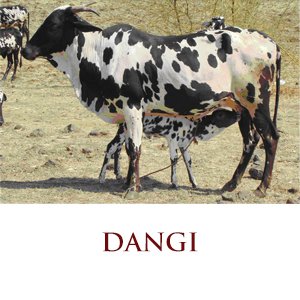Dangi

Dangi is a cattle breed belonging to the Dangs Ghat – the hilly regions of Maharashtra. It habitats Thane district, Sinner and Igatpuri taluka of Nasik district and in Akola taluka of Ahmednagar district. It originates from the hilly tracts of the Dang district of Gujarat where the rainfall is very heavy and the agricultural economy is very poor. Generally these animals occur near the hilly tracts where forests are available in the ranges of Sahyadri.
This breed is similar to the Deoni and appears to fit into the group of cattle represented by Gir, Red Sindhi and Sahiwal. The breed is also known as the “Kanadi”. The total estimated population of Dangi ranges from 2 lakhs to 2.5 lakhs in numbers.
The Dangi are in essence a medium-slow draft breed, known by and large for its hardy nature and ability to work in heavy rainfall areas, rice fields and hilly tracts. These animals subsist to a large extent on grazing. They animals are useful for ploughing and other field operations, and also for carting timber from forest areas. They are notable to carry heavy timber, at the rate of 2 to 3 miles per hour, depending upon the type of terrain and can thus cover a distance of 20 to 24 miles at ease per day. Cows of this breed are poor milkers, though attempts are made to improve their milking capabilities.
Types:-
There are six different strains of the Dangi animals which are set apart as per the coar colour and are known by their local names. “Para” is completely white with a few black spots and males of this type are held valuable. “Bahala” is a combination of white and black – when white colour is relatively more, it is familiar as “Pandhara Bahala” and when black is relatively more, it is familiar as “Kala Bahala”.
“Maneri” means complete black with few white spots. These strains of animals are found in the Ahmadanagar and Nashik district and the Dangs district.
“Lal” means more of red colour with few white spots while “Lal Bhahala” is a combination of red and white. These are found mostly in Dangs and Nashik district.
Characteristics:
- The cattle are medium to large in size, with deep bodies and a ponderous build.
- They have powerful hind and forequarters with a short back.
- The legs are short and stout and the hooves are black, flint-like and hardy.
- The skin is of medium thickness and secretes an oil element that enables them to tolerate heavy rains.
- The head is of moderate size and proportionate to the body while the ears are small.
- The forehead is protrudes a but, the muzzle is large.
- The hump is medium-sized and firm; the dewlap is a bit pendulous.
- The horns are short and thick with lateral pointing tips. Animals with inward and also downward pointing horn tips are also found in sizeable numbers.
- The sheath is loose but not pendulous by an excess. The height behind the hump ranges from about 45 to 50 inches while the heart girth measures from about 58 to 60 inches, on the average.
- The average weight for males is 310-330 kgs and for females 220-250 kgs.
- The age at first calving is 46 -56 months and calving interval is about 17- 21 months.
- The milk yield averages about 530 kg (range 32 to 1,228 kg) in an average lactation period of 269 days (range 100 to 396 days). The fat percentage in the milk ranges from 3.8 – 4.5 %.
Indian Cow Facts
The total estimated population of Dangi ranges from 2 lakhs to 2.5 lakhs in numbers.
There are six different strains of the Dangi animals which are distinguished according to their coat colour and are known by their local names. “Para” is completely white with a few black spots and males of this type are considered very valuable. “Bahala” is a combination of white and black - when white colour is relatively more, it is called “Pandhara Bahala” and when black is relatively more, it is known as “Kala Bahala”.
“Maneri” means complete black with few white spots. These strains of animals are found in the Ahmadanagar and Nashik district and the Dangs district.
“Lal” means more of red colour with few white spots while “Lal Bhahala” is a combination of red and white. These are found mostly in Dangs and Nashik district.
